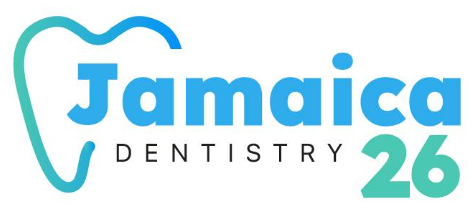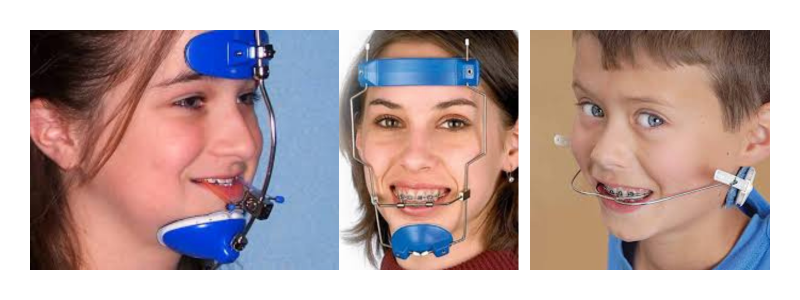Headgear
Headgear That Fixes Overbites & Jaw Issues Without Pain
Orthodontic headgear is a highly effective solution for correcting overbite and guiding jaw alignment, especially in growing children and teens. Unlike braces that only shift teeth, headgear applies a gentle, consistent external force to redirect jaw growth and ensure proper bite structure. Modern headgear designs are lighter and more comfortable, using adjustable straps and face bows to minimize irritation and improve fit. When prescribed and monitored by experienced professionals, this appliance can prevent the need for more invasive treatments. At Jamaica 26 Dentistry, we deliver contemporary, patient-friendly orthodontic treatments tailored to each individual’s orthodontic needs.
What Is Orthodontic Headgear?
Orthodontic headgear is a specialized dental device worn in conjunction with braces in order to correct biting issues and crooked jaw problems that cannot be corrected with braces alone. It does this by exerting a uniform safe pressure on the teeth and the jaw, which over time directs the mouth into the ideal alignment. It can be especially useful in curing overbites, underbites, crossbites or jaw growth discrepancies in children and adolescents.
A typical headgear setup includes:
Facebow: A metal frame that fits into the braces or bands on the back teeth.
Neck strap or head cap: worn around the neck or head to anchor the device.
Inner and outer traction: the pulling force that moves the teeth or jaw in desired direction.
As the newer forms of treatment, such as Invisalign, have become more common, headgear plays a vital role in more complicated orthodontic cases where adjustment of jaw is required.It is most effective during the growing years but can also be adapted to include certain adult treatments.
When Is Orthodontic Headgear Necessary?
- Orthodontic headgear is prescribed for certain bite and jaw problems that braces or aligners cannot rectify. Among the most popular causes is to fix overbites, where the lower front teeth are visible due to their protrusion by the upper front teeth. This situation may lead to wear imbalance, jaw discomfort, and aesthetic issues.
- Underbites (lower jaw is further forward than the upper jaw) can also be treated by the use of headgear. Through the administration of controlled force, headgear can help direct the jaw growth as well as enhance the general bite relationship particularly in the young patients who are still in their developmental stage.
- Where the upper and lower jaws are developing at different speeds, headgear is important in aligning the jaws harmoniously. These inconsistencies can be so extreme that clear aligners or braces are not enough to solve the problem.
- Orthodontists usually suggest beginning the training with headgear in childhood or early adolescence, when the jawbones are still maturing. Early treatment uses the natural growth of the body and therefore results in a more effective treatment, and in many cases, treatment does not require more invasive treatment in the future.
- To put it simply, headgear is not just an “outdated” appliance; it is a current, fundamental approach to attain precise bite adjustment and long-term orthodontic stability.
Advantages of Modern Orthodontic Headgear
1. Targeted Jaw or Bite Correction
Advanced headgear provides an accurately focused force to either move teeth or to direct jaw development wherever indicated. This is a more targeted procedure, limiting impact to specific areas, making it especially effective for correcting overbites, underbites, or jaw discrepancies that conventional braces alone cannot fix.
2. Faster Results in Specific Cases
When deployed in the case of growing children and teens, it is possible to achieve positive effects within a shorter period using headgear. Since it operates on the body’s natural growth process, some bite fixations are possible in a relatively short period of time, as opposed to fixing the bite using braces or aligners only.
3. Designed for Comfort
Current orthodontic headgear consists of lightweight, soft, padded straps and can cause less painful skin irritation. Contemporary styles lose their place more discreetly, which makes them comfortable to wear regularly.
4. Compatible with Braces or Fixed Appliances
With or without braces, other fixed orthodontic appliances, the use of headgear can complement overall treatment. Through the collaborative approach, the orthodontist will be able to deal with several problems simultaneously, resulting in a more efficient and thorough approach.
How It Works: Step-by-Step Process
Orthodontic headgear use is mainly to exert a continuous slight pressure that directs teeth and jaw development into proper place. The steps below give a breakdown of each step so you know what to expect every step of the way.
Step 1: Initial Assessment & Treatment Planning
The first step in your process is an evaluation at Jamaica 26 Dentistry thorough orthodontic evaluation. This will comprise digital x-rays, photos, and bite impressions in order to determine your teeth and jaw alignment. The orthodontist examines your jaw growth and evaluates the level of overbite, underbite or crossbite. In the case that headgear is the most reasonable option, they will draw up an individualized regimen, covering the anticipated schedule and any other devices that might prove necessary along with it.
Step 2: Custom Headgear Fitting
When the plan is determined your headgear should be fitted to your head in a manner as to be as comfortable and as efficient as possible. The force will just be applied in the right direction, by clasping the face bow (the metal piece that fits in the mouth), the straps and the points of fastening by the orthodontist. Lightweight and soft cushioning to minimize irritation. You will also be demonstrated how to wear it and remove it.
Step 3: Wear Schedule & Daily Instructions
Headgear should be worn 12-14 hours a day commonly in the evenings and during sleeping times to deliver the greatest output. Your orthodontist will suggest the cleaning, storing, and handling tips. No rough play at all in it or contact sport, and do take it off when you are about to eat or when brushing. The trick to rush is consistency.
Step 4: Monitoring & Adjustments
It is important to make follow-up visits every few weeks. These visits are to inspect progress, update the tension and to make sure the fit remains comfortable. Such visits also prevent any minor soreness before it becomes a problem.
Step 5: Transitioning Off
As soon as your bite and jaw are in their optimal alignment you will gradually wear down the time. The second step usually entails the use of retainers or braces to retain everything in position. This is the retention period that will help you achieve long-term success because your smile will be straight and healthy.
Real-Life Benefits & Patient Experience
- The patients who undergo the process of the headgear treatment tend to observe life-altering outcomes. The most evident change is the aligned jaw and an established bite, which makes chewing and speech relaxed. Most people also have a more balanced facial structure, less strain placed on the jaw joints, and muscles. Daily chores such as taking a bite out of an apple or a steak are much easier.
- Beyond the functional gains, the psychological benefits are just as powerful. Better facial symmetry and confident smiles can help patients feel consistently better about themselves, as confidence increases self-esteem in social, school, and working environments.
- These findings are most likely due to wearing the headgear consistently, as advised and maintaining all the check-up visitations. By strictly adhering to orthodontic instructions given to them, patients tend to accomplish long-term, predictable results in a shorter time.
- With the help of modern headgear at Jamaica 26 Dentistry, the procedure becomes calmer and more convenient to engage in; it is less noticeable as well. Their experience means that each of their patients will not only have straight teeth, but a far healthier bite and a boost of confidence in their future.
Why Early Action With Headgear Matters
Orthodontic headgear is effective when the jawbones are still developing, because they can be directed to the right path easier during this period. By making the move to treat overbites, underbites, or misaligned jaws at an early age, not only is a faster treatment process currently possible, but the potential to avoid the necessity of additional measures requiring more invasive treatment, such as orthognathic surgery later in life, becomes feasible. When applied at an appropriate time, headgear is capable of making bite function, facial balance and even speech articulated better. Moreover, timely orthodontic treatment minimizes the vices of wearing teeth asymmetrically, discomfort during eating, and jaw pain. This is because early treatment especially at age 9 or early teens (highly effective in this process) will lead to permanent results and prevent difficulties in orthodontic cases in the future.
Conclusion
Orthodontic headgear continues to be one of the most accurate and very useful in addressing over bites, under bites as well as misaligned jaws particularly at a child or a teenage stage of growth. These new constructions are less dense, comfortable and are used to go together with braces in order to achieve faster, focused outcomes. The headgear is able to help develop a balanced profile, enhanced chewing and permanent self-esteem as it guides jaw growth and straightens the bite at an early age.
Suffering a bite or feeling pain in your jaw, it is the best time to find a solution to the problem, since now you have an opportunity to employ this technique that has been tested many times to help people and has proven to be efficient and non-invasive. To determine whether headgear is the next step towards the healthiest, most confident smile, book a consultation at Jamaica 26 Dentistry.
FAQs
1. Is headgear painful or uncomfortable to wear?
Today, orthodontic headgear is made for comfort. Gentle pressure or moderate discomfort might occur during the initial couple of days, yet usually subsides when improved. Cushioned straps and light-weight materials assist everyday putting on really feels extra all-natural.
2. Can I play sports or eat while wearing headgear?
To prevent food damage or injury, one should take off headgear when eating or when playing a contact sport. It can be best used in silent moments like during homework, reading, or sleeping.
3. How long does treatment with headgear usually take?
The time treatment differs, depending on the intensity of the bite or jaw problem. Most patients wear headgear 12-14 hours a day on average, with 6-18 months being typical length of time of wearing them.
4. Will using headgear affect my speech or sleep?
It can have a minor effect on speech during the couple of days but a majority of the patients catch up very fast. Headgear is usually worn at night hence it does not disturb the sleep once you are accustomed to it.
5. Is headgear suitable for adults, or just children/teens?
Headgear works best when children and teens are at a period of growth, but some adult patients might see some benefit as well, depending on treatment issues, such as bite correction in which jaw surgery is unnecessary.

